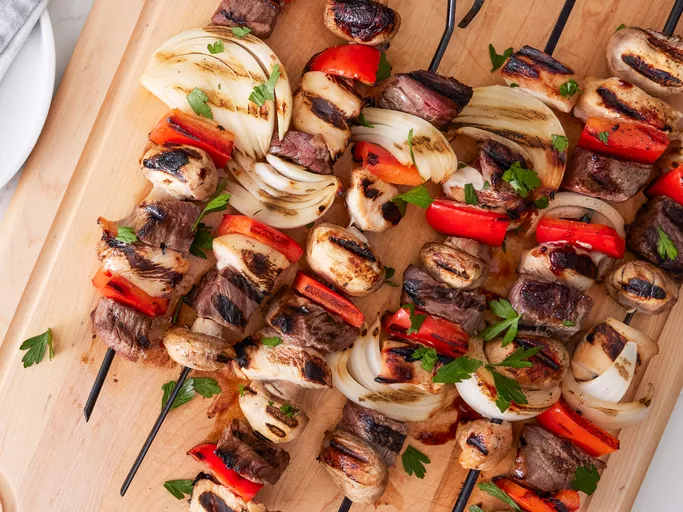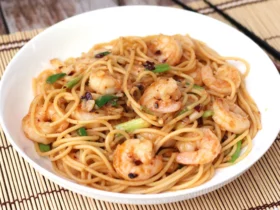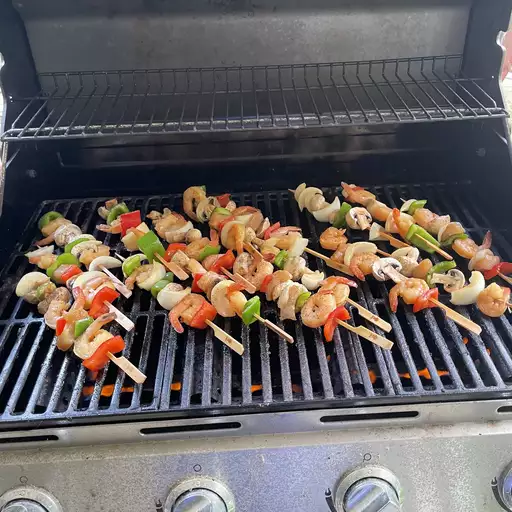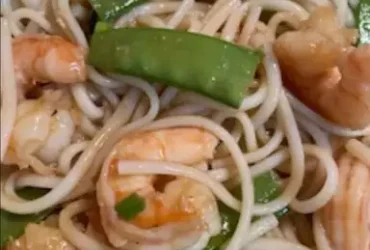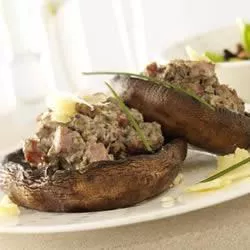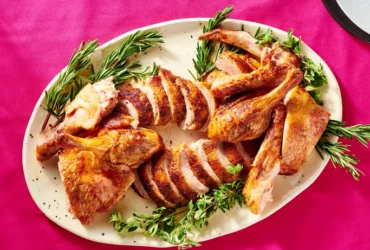Ingredients
Cut up your favorite meats into bite-sized pieces.
To prepare delicious kabobs, you’ll need to start by cutting up your favorite meats into bite-sized pieces. This will ensure that each piece of meat cooks evenly and quickly on the grill.
Here’s a list of some popular meats commonly used in kabob recipes:
- Boneless chicken breast, cut into 1-inch cubes
- Cut beef strips (such as sirloin or ribeye), sliced into 1-2 inch pieces
- Shrimp, peeled and deveined, cut in half lengthwise
- Lamb, cut into 1-2 inch cubes
You can also include vegetables like mushrooms, bell peppers, onions, cherry tomatoes, and pineapple chunks to add flavor and nutrients to your kabobs. Be sure to cut these into similar bite-sized pieces so they cook evenly.
Other ingredients you may want to consider adding to your kabob recipe include:
- Olive oil for brushing the kabobs
- Soaked wooden skewers or metal kabob sticks
- A marinade of lemon juice, garlic, and herbs like oregano or thyme to give your kabobs extra flavor
- Cheese, such as feta or mozzarella, for an added burst of flavor (optional)
Remember to adjust the amount of ingredients based on how many people you’re serving and their individual preferences. You can also customize your kabob recipe by using different combinations of meats and vegetables.
Cubes of beef or lamb are classic choices, but feel free to mix it up with chicken, pork, or even seafood for a different twist.
The choice of ingredients can vary greatly when it comes to making kabobs. Cubes of beef or lamb are classic choices, but feel free to mix it up with chicken, pork, or even seafood for a different twist.
Cubed beef or lamb is the most traditional and common ingredient used in kabob recipes. These meats have a great balance of flavor, tenderness, and texture that make them perfect for skewering and grilling.
When choosing cubed beef, look for cuts like sirloin, ribeye, or round. These cuts are tender, flavorful, and will hold their shape well on the kabob.
If you prefer lamb, go for leaner cuts like leg of lamb or shoulder, which have a milder flavor than fattier cuts.
Chicken is another popular choice for kabobs, and it’s often preferred by those looking for a lighter option. Opt for boneless, skinless chicken breast or thighs for the best results.
Pork is also a great alternative to beef or lamb, especially if you’re looking for a slightly sweeter flavor. Choose tender cuts like pork loin or belly for the best texture and taste.
Seafood kabobs are perfect for seafood lovers! Shrimp, scallops, and chunks of fish like salmon or tilapia make great additions to your kabob recipe.
Remember, when working with any type of meat or seafood, it’s essential to handle them safely and hygienically. Always wash your hands before handling the ingredients, and store raw meats in a separate container from cooked foods to prevent cross-contamination.
To add some extra flavor to your kabobs, consider mixing in some vegetables like bell peppers, onions, mushrooms, and cherry tomatoes. These will not only add texture and color but also help keep the meat moist and juicy while grilling.
Some other ingredients you might want to consider adding to your kabobs include:
Fruits: Try adding chunks of pineapple or peaches for a sweet and savory twist on classic kabobs.
Spices and herbs: Add some cumin, coriander, or paprika to give your kabobs a Middle Eastern flair, or try using fresh herbs like parsley, cilantro, or thyme for a brighter flavor.
Nuts or seeds: Chopped almonds, pistachios, or sesame seeds can add a nice crunch and nutty flavor to your kabobs.
Add some vegetables to the skewer – bell peppers, onions, mushrooms, and cherry tomatoes are all great options.
To add some variety to your kabob recipe, consider adding a selection of colorful vegetables to the skewer. Here are some delicious options:
- Bell peppers – Green, red, or yellow bell peppers all add a sweet and crunchy texture to your kabobs.
- Onions – Whether you use white, yellow, or red onions, they bring a punch of flavor and a bit of sweetness.
- Mushrooms – Button mushrooms or cremini mushrooms are great choices for kabobs. They have a meaty texture that pairs well with vegetables and meats.
- Cherry tomatoes – Halve or quarter cherry tomatoes to add bite-sized bursts of juicy sweetness to your kabobs.
When adding these vegetables to your skewer, be sure to alternate them with pieces of meat, seafood, or tofu to create a visually appealing and balanced presentation. You can also use different combinations of vegetables and meats to suit your taste preferences.
Some other vegetable options you might consider adding to your kabobs include:
- Zucchini – Sliced or spiralized zucchini adds a refreshing crunch to your kabobs.
- Courgette – Similar to zucchini, courgette brings a light and refreshing flavor to your kabobs.
- Pineapple – Fresh pineapple chunks add a tropical twist to your kabobs and pair well with sweet or savory flavors.
Remember to oil the vegetables and meat pieces before grilling to prevent sticking, and serve your kabobs hot off the grill. Enjoy!
Marinating and Seasoning
Create a flavorful marinade by combining olive oil, lemon juice, garlic powder, salt, and any other herbs or spices you like.
The art of marinating and seasoning is a crucial step in creating delicious kabobs. Marinating is a process that involves soaking food, typically meat or vegetables, in a seasoned liquid to add flavor and tenderize it.
For our kabobs recipe, we’ll start by making a flavorful marinade that combines the right balance of acidic, sweet, salty, and savory flavors. Here’s what you’ll need:
- Olive oil: This will be the base of our marinade, providing richness and moisture to our kabobs.
- Lemon juice: The acidity in lemon juice helps break down proteins and adds a bright, citrusy flavor to our kabobs.
- Garlic powder: This is where we’ll add some depth and warmth to our marinade. You can also use minced garlic if you prefer the fresh flavor.
- Salt: This will enhance the natural flavors of our ingredients and help bring everything together.
- Herbs and spices: Feel free to add your favorite herbs and spices to create a unique flavor profile for your kabobs.
Some options include:
- Paprika
- Cumin
- Coriander
- Thyme
- Oregano
Now that we have our marinade ingredients, let’s talk about how to combine them. In a large bowl, whisk together:
- 2 tablespoons olive oil
- 1 tablespoon lemon juice
- 1 teaspoon garlic powder
- 1/2 teaspoon salt
- Add your favorite herbs and spices to taste
Mix everything together until it’s well combined, then add your kabob ingredients. You can use chicken, beef, pork, lamb, or a combination of different meats and vegetables. Make sure they’re evenly coated with the marinade.
Cover the bowl with plastic wrap or a lid and refrigerate for at least 30 minutes to an hour, or up to several hours if you have time. The longer it marinates, the more flavor it will absorb.
Once your kabobs are marinated, preheat your grill or grill pan to medium-high heat. Thread the ingredients onto skewers and cook for 10-15 minutes, turning occasionally, until they’re cooked through and slightly charred.
Serve hot with a side of your favorite sauce or salad, and enjoy the fruits of your labor!
Pour the marinade over your meat and veggies, making sure they’re fully coated – let it sit for at least 30 minutes to allow the flavors to penetrate.
The art of marinating and seasoning is an essential part of creating a delicious kabob recipe. Before we dive into the actual cooking process, it’s crucial to prepare our ingredients with the perfect blend of flavors.
Marinating involves soaking your meat and vegetables in a mixture of acidic ingredients like vinegar or lemon juice, oils, herbs, spices, and other flavor enhancers. This process helps break down the proteins in the meat, tenderize it, and infuse it with the desired flavors.
To marinate, you’ll typically combine ingredients such as olive oil, minced garlic, chopped fresh herbs like parsley or cilantro, salt, pepper, and any other desired spices or seasonings. You can also add acidic ingredients like soy sauce, wine vinegar, or citrus juice to help break down the proteins and enhance the flavors.
Once you’ve mixed together your marinade, it’s time to pour it over your meat and veggies. Make sure they’re fully coated in the marinade, as this will allow them to absorb the flavors evenly. You can use a brush or simply toss them to ensure everything gets a good coating.
After pouring the marinade over your ingredients, let them sit for at least 30 minutes to allow the flavors to penetrate. This is an important step, as it allows the acidic ingredients in the marinade to break down the proteins and infuse the meat with flavor. The longer you marinate, the deeper the flavors will be.
Some general guidelines for marinating times are:
- Mild meats like chicken or fish: 30 minutes to 2 hours
- Beef and lamb: 2-4 hours or overnight (8-12 hours)
- Tougher cuts of meat: 4-6 hours or overnight (8-12 hours)
Remember, the key to a great kabob recipe is not just about the marinade and seasoning, but also about cooking your ingredients evenly. To achieve this, it’s essential to cook them over medium-high heat, using a mixture of direct and indirect heat.
In addition to marinating and seasoning, there are several other tips you can follow to create the perfect kabobs:
- Use high-quality ingredients: Fresh herbs, spices, and oils will make a big difference in the flavors of your kabobs.
- Avoid overcooking: Cook your kabobs until they’re just done, as this will help preserve their natural flavors and textures.
- Add aromatics: Onions, garlic, and other aromatics can add depth and complexity to your kabob recipe.
By following these tips and experimenting with different marinades and seasonings, you’ll be well on your way to creating delicious and memorable kabobs that will impress your friends and family. Happy grilling!
Cooking and Serving
Preheat your grill to medium-high heat and brush those skewers with a little bit of oil to prevent sticking.
- To start cooking delicious kabobs, it’s essential to preheat your grill to medium-high heat.
- This will ensure that your food cooks evenly and quickly, locking in all the flavors and juices.
- While the grill is heating up, prepare your skewers by threading meat, vegetables, and fruits onto them in an alternating pattern.
- This not only adds visual appeal to your kabobs but also ensures that each piece of food has a good balance of flavors and textures.
- To prevent the skewers from sticking to the grill, brush them lightly with a little bit of oil. You can use vegetable oil, olive oil, or any other oil of your choice.
- Making sure that each piece of food is coated with a small amount of oil will help create a nice glaze on the kabobs as they cook.
- Once the grill is hot and the skewers are ready, place them on the grill and cook for 8-10 minutes, turning occasionally to ensure even cooking.
- When you think the kabobs are cooked through, remove them from the grill and let them rest for a few minutes before serving.
- This allows the juices to redistribute, making each bite more flavorful and juicy.
- Serve your delicious kabobs hot, garnished with fresh herbs like parsley or mint, and enjoy!
Cook the kabobs for 8-10 minutes per side, or until they’re nicely charred and cooked through – serve hot and enjoy!
To cook and serve delicious kabobs, it’s essential to follow some basic steps. First, prepare the ingredients according to the recipe you’re using, which should include marinating the meat in a mixture of olive oil, lemon juice, garlic, and your choice of herbs and spices.
Skewer the marinated meat onto metal or wooden kabob skewers, leaving some space between each piece for even cooking. You can also add vegetables like bell peppers, onions, mushrooms, and cherry tomatoes to the skewers.
Preheat a grill or grill pan over medium-high heat. Place the kabobs on the grill and cook for 8-10 minutes per side, or until they’re nicely charred and cooked through. You can check the internal temperature of the meat by inserting an instant-read thermometer into the thickest part of each piece.
Once the kabobs are cooked, remove them from the heat and let them rest for a few minutes before serving. This will allow the juices to redistribute within the meat.
Finally, serve the kabobs hot and enjoy! You can garnish them with fresh herbs, lemon wedges, or a side of your favorite sauce. Some popular options include tzatziki, hummus, or a simple yogurt-based sauce flavored with garlic and dill.
To add an extra touch to your meal, consider serving the kabobs with some flavorful sides like grilled pita bread, roasted vegetables, or a salad made with mixed greens, cherry tomatoes, and a light vinaigrette.
- Best Datanyze Alternatives for 2025 - April 24, 2025
- Best Hunter.io Alternatives for 2025 - April 22, 2025
- Best Lead411 Alternatives for 2025 - April 22, 2025

